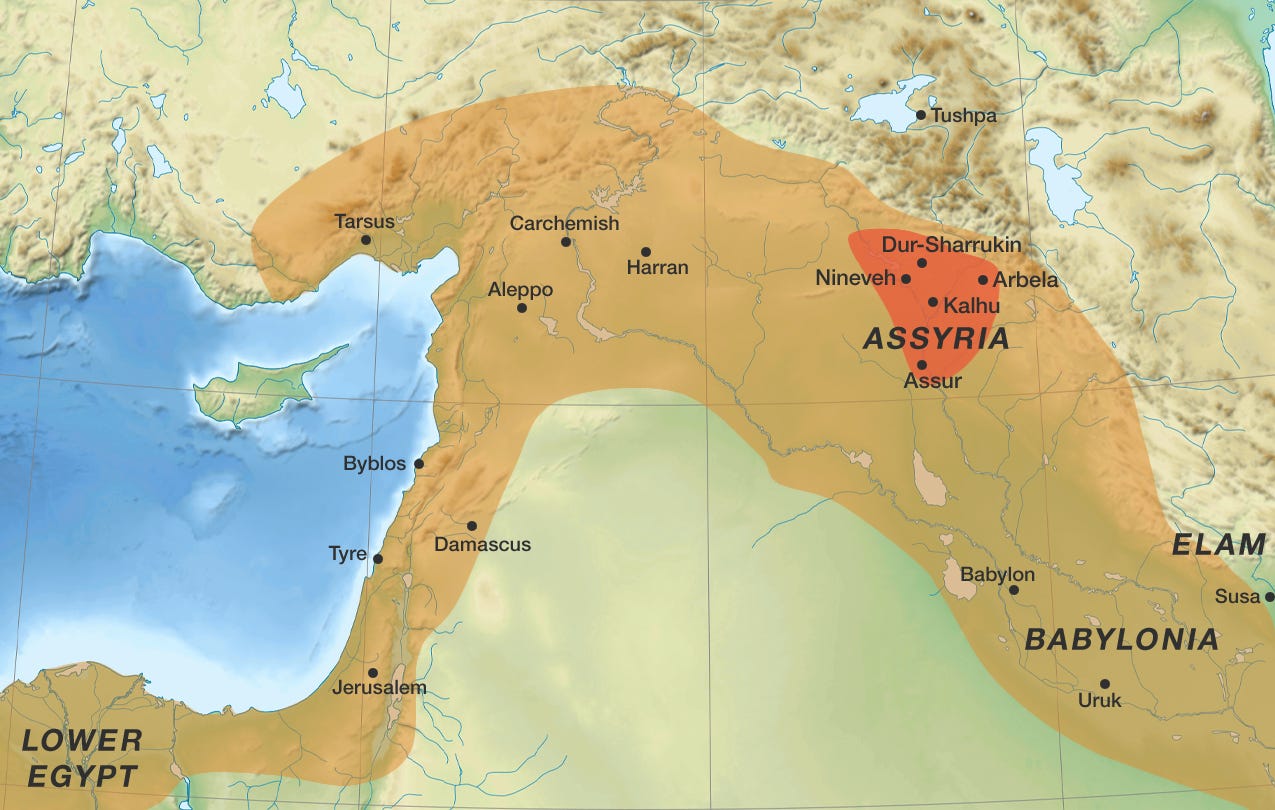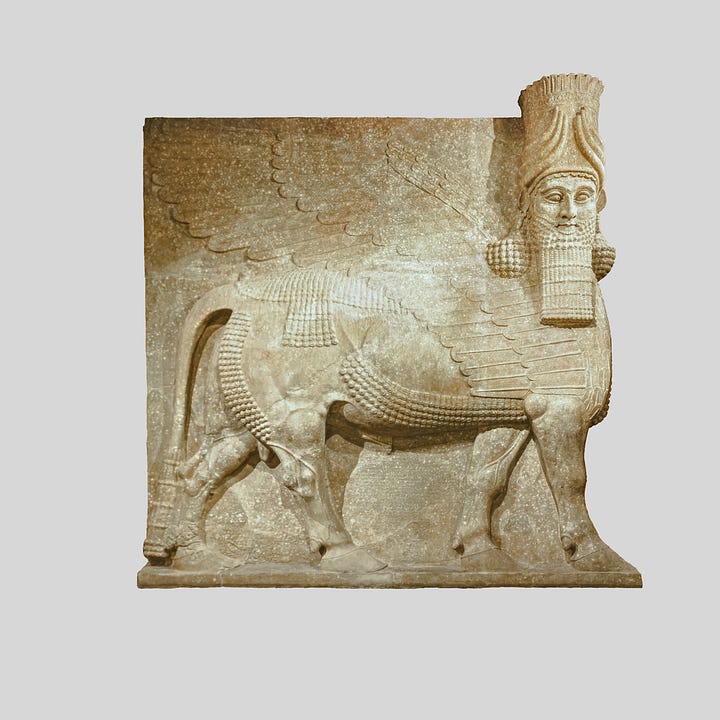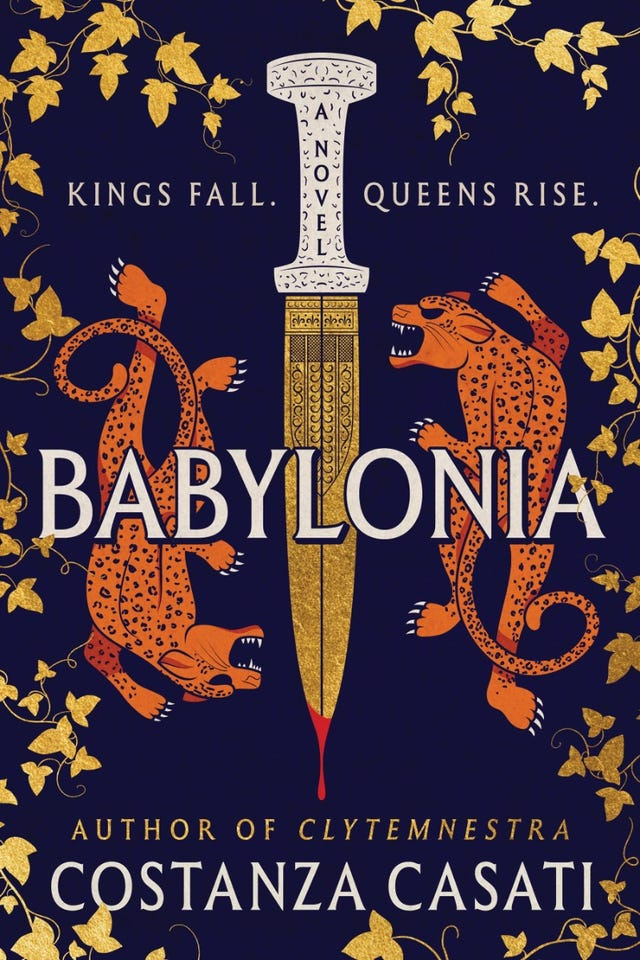Book Review: "Babylonia" by Costanza Casati
A riveting novel about Semiramis, the Assyrian woman who became a diplomat, a warrior, and a queen.
“All women's destinies are doomed to be the same,” the bârû has told her.
No, she thinks. They aren't. Let the gods learn that.
Through the choking dust and timeworn pages of history walks a monumental woman, her steps proudly echoing across the sun-cracked earth, glittering palaces and temples, and luscious gardens over which she ruled: the Assyrian queen Semiramis. In her novel Babylonia, Costanza Casati infuses life into Semiramis’s mythical tale, weaving together legend and fact into a glorious tapestry of love, loss, and the heights to which men and women rise…and fall.
For a deep insight into the author and how she crafted this masterpiece, please check out this amazing interview by
!I’m excited to share my thoughts about this book in my first review of 2025!
Historical Notes
(Author’s note: normally I like to include a historical context when writing some book reviews to help readers better understand and engage with the reviewed book. In this case, I wanted to point readers at the historical period in which this book is set, a couple of historical sources for reference, and a couple of pieces of artwork.)
Historical Context
It’s not my intention to dive into the long history of the Assyrian Empire. The massive empire, its capital of Assur centered on the western banks of the Tigris River, spanned hundreds of years, and the extent of its borders ebbed and flowed from between 1365 BCE until its fall in 609 BCE. Babylonia takes place during the Neo-Assyrian period (9th to 7th centuries B.C.E.). It was during this time - in the Empire’s latter centuries - that Assyria expanded its borders and consolidated military successes under rulers such as Ashurnasirpal II (r. 883–859 B.C.E.) and Shalmaneser III (r. 858–824 B.C.)1 Shalmaneser’s son Shamshi-Adad V succeeded him and features prominently in Babylonia.

Literary, Artistic, & Historical Source Inspiration
To frame her novel and each protagonist’s storyline, author Costanza Casati draws heavily on a book called The Library of History by the ancient Greek historian Diodorus Siculus. The Library of History provides a sprawling historical and cultural overview of ancient Egypt, Mesopotamia, India, Scytha, Arabia, North Africa, Greece, Europe, and historical events and persons from the Trojan War and Alexander the Great down to the Gallic Wars.
Additionally, the relationship between Shamshi-Adad and his official Onnes mirrors that of characters in The Epic of Gilgamesh, an ancient Mesopotamian epic and the oldest known literary work.
Finally, Casati references Assyria’s rich artistic heritage, spanning from magnificent palaces to lamassu, a protective Mesopotamian deity. A few allusions I found (though I can’t claim to know precisely where the author found inspiration, of course) include an ivory plaque of a lioness mauling a young man and lamassu statues. More artistic descriptions pepper the novel, making for a much more engrossing read.


Synopsis
Set in the 9th century BC, Semiramis’s story takes place during a tumultuous time in Assyrian history, during the reign of Shamshi-Adad V (also known as Ninus, that being the king's personal name). The king seeks to exert control over rebel areas, including the village of Mari in the Eber-Nari province, in the aftermath of a devastating civil war.
Orphaned as a young girl, Semiramis grows up in Mari in the care of a shepherd. Our cunning and ambitious heroine seeks to escape her village and seizes the opportunity when she meets Onnes, Eber-Nari’s governor. Intrigued by Semiramis, Onnes marries her, and they leave for the Assyrian capital of Kalhu. It’s there where Semiramis begins her ascent to power.
Little does Semiramis know that the halls of Kalhu’s palaces pulse with intrigue and political ploys. Several factions vie for power at court, including the king’s mother, his general, and his spymaster. And yet, Semiramis refuses to remain idle and upends traditional women’s roles as a submissive wife and procreator. Instead, she serves on Ninus’s council to advise him and helps with planning military campaigns to further Assyria’s domains.
Tensions arise, however, among the king’s court, and between Semiramis, Onnes, and Ninus. A love triangle envelops the three protagonists, and Semiramis doesn’t realize at first that the bond between the two men transcends her understanding. It’s a complex and complicated web, one that brings both halcyonic joy and unspeakable sorrow.
Through it all, Semiramis evolves into a diplomat, a warrior, a queen, one whose influence and legend will resonate throughout history.
Review
Casati's breathtaking second novel plunges readers into ancient history in all its glory, beauty, and violence. Through meticulous research of sources and artwork, she crafts a vibrant and authentic world. Readers stride past the towering lamassu guarding Kalhu’s gates into the city, revel in the beauty of terraced gardens, inhale the dust of marching armies, and hear the whisperings of political intrigue throughout palace halls. To be honest, it feels like a window to the ancient past, one about which we can only dream.
Semiramis is portrayed as a complex, layered, and flawed protagonist. Though abused by her adopted father, the young woman refuses to be a victim. Instead, Semiramis unapologetically seizes opportunities to better herself and advance her position, first when she marries Onnes, and then, after the death of her second husband, Ninus himself. Her bravery, ferocity, intelligence - and occasionally her ruthlessness and cunning - reverberate throughout the land as Semiramis joins military campaigns, plots the downfalls of her enemies, and, ultimately, ascends the Assyrian throne to rule on behalf of her son.
And yet, Casati also paints the Assyrian queen with a softer brush. Semiramis remains approachable to her servants, treating them with politeness and even kindness. She tries to protect women and children when she can at the risk to her own life. Semiramis even befriends a foreign hostage. This multifaceted presentation creates for readers a mosaic of a character.
I particularly enjoyed Casati's exploration of Semiramis's grappling with the emotional and psychological impacts of war and her actions in them. Babylonia offers a deeply nuanced interpretation of both the trauma endured but also the bonds forged in such horrific environments and adversity as a result of battle.
On the whole, Babylonia strikes a perfect chord of known fact and cultivated legend, narrative description and immersive dialogue, and intriguing characters and riveting plot.
The novel comes out in the United States on January 14th, and I'm grateful for the author and publisher for an eARC copy via NetGalley!
Book Summary
Title: Babylonia
Author: Costanza Casati
Publisher: Sourcebooks Landmark
Publication Year: January 2025
Page Count: 448pp
Featured image: Semiramis Receiving Word of the Revolt of Babylon, Giovanni Francesco Barbieri, oil on canvas, 1624 (Museum of Fine Arts Boston, 48.1028)
Department of Ancient Near Eastern Art, “Assyria, 1365–609 B.C.,” in Heilbrunn Timeline of Art History (New York: The Metropolitan Museum of Art, 2000–), http://www.metmuseum.org/toah/hd/assy/hd_assy.htm (originally published October 2004, last revised April 2010).








This looks intriguing and I must add that the cover is lovely. Great review!
Thank you for this excellent review, Amy! I especially appreciated the historical background as its setting is very different to anything I’ve read before.